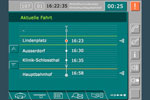Development of visual user interfaces and working prototypes
The most important thing, when developing new interfaces is, to make the design logical and the functional principle understandable. Usability is an important part of the whole look and feel.
A prototype of a new software based device is a vital instrument for making the right design decisions. It is also a good tool for usability tests and can even be used for training purposes.
For me working alongside graphic designers and engineers is enjoyable. It feels great to shape a part of the future.
Following are two examples of work, I did together with quadesign partner ag.
Interface of a fully digital x-ray system for Swissray (2006)
Especially in medical applications it is important, to rule out all possible operating errors. This means not only that there are particular high hard- and software requirements to meet, but also to guide the medical personal in making the decisions.
In this project I worked with a design team at the development of a simulation, which Swissray was using for marketing research.
Interface for Siemens' Orientation and Communication System for Bus Drivers (2005)
The aim of this system was to help bus drivers in the city of Winterthur to operate a fair amount of technical equipment with one device and one easy-to-use interface.
A challenge was to design an interface which can be operated in the vibrating bus while driving. I programmed a working prototype which was also used for usability tests.
The System was featured in the Swiss TV science magazine «Einstein» from 28.06.2007. Here is the video in German/Swiss German.
Programming visualizations
Programming is often an effective way to not only simulate but also visualize complex processes.
This can be used for science, in exhibitions or just for fancy business presentations.
As an example:
«das visuelle gedächtnis» (2006)
«das visuelle gedächtnis» is an interactive attempt of Claudius Fischer and me to show the visual memory of a human being. Therefor Claudius chose the analogy of an universe in which each thought or segment of the memory is represented by a picture and one word.
During brainstorming and discussions we came up with the idea, that each object (thought) is floating on the screen and growing if the user is pointing at it – if clicked, the thoughts content will be exhibited to the user.
Each object can be rated in seven different categories. The less the objects are differing from each other the more they are attracted to while floating. This means that the thoughts are organizing themselves in topic related groups. This makes it easier to navigate through them.
Coding for art
Creating interactive art installations is the most interesting and challenging work: Most often skills are required in the fields of electronics and programming. The installations have to work without any interruptions while displayed in an exhibition - even though they are just prototypes.
By supporting students during my time as an assistant I could gather a lot of experience. Ever since I helped several artists to meet their technical challenges and did some of my own projects.




